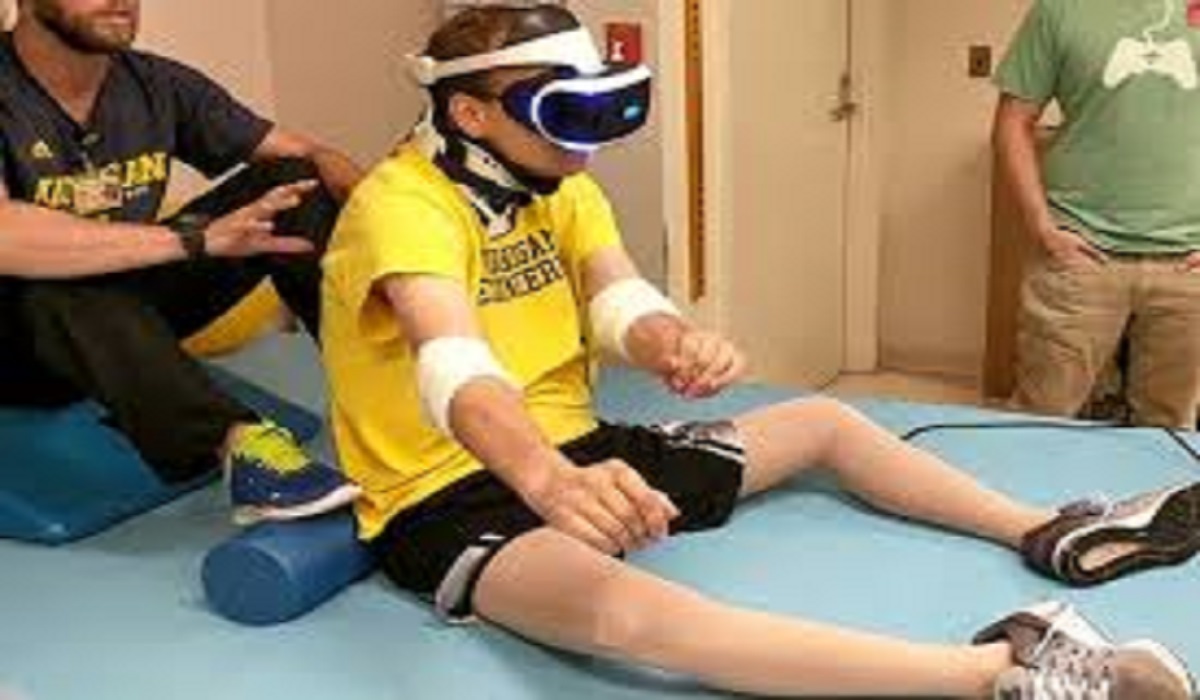VR Sports Fan Isolation Syndrome
VR Sports Fan Isolation Syndrome: The roar of the crowd, the shared groans at a missed call, the high-fives with strangers when your team scores—these moments are the heartbeat of being a sports fan. But what happens when the stadium is your living room and the crowd is a collection of digital avatars?
Virtual reality (VR) offers an incredible new way to watch games, but it also introduces a new challenge some are calling VR Sports Fan Isolation Syndrome – Latest. This article explains what this condition is, why it might affect you, and how you can enjoy VR sports without losing the human connections that make sports fandom so special.
A New Way to Watch Sports: The Rise of VR Viewing
Imagine putting on a headset and suddenly finding yourself in a virtual suite at the fifty-yard line. You can look around the entire stadium, see players up close, and even access real-time stats with a glance. This is the promise of VR sports broadcasting. It provides an immersive experience that a standard television screen cannot match.
For fans living far from their favorite teams, it can feel like a dream come true, offering a front-row seat from thousands of miles away. The technology behind VR Sports Fan Isolation Syndrome – Latest developments is truly remarkable, creating a sense of presence that was once impossible.
However, this incredible technology has a subtle side effect. The very thing that makes VR so engaging—its ability to block out the physical world—is also what can lead to a sense of detachment. While you are visually and audibly immersed in a game, the people in the room with you are invisible.
You cannot easily share a snack, nudge a friend during a close play, or see the genuine smile on your child’s face. This separation between the virtual event and your physical environment is the starting point for understanding VR Sports Fan Isolation Syndrome – Latest concerns. It is a trade-off between immersion and shared reality.
What is VR Sports Fan Isolation Syndrome?
VR Sports Fan Isolation Syndrome is not a formal medical diagnosis. Instead, it is a term used to describe a collection of feelings that some people report after frequently using VR to watch sports. These feelings include loneliness, a sense of disconnection from friends and family, and even a duller emotional experience over time.
It is the gap between the thrilling virtual world and the quiet, empty room you find yourself in when the headset comes off. Recognizing the signs of VR Sports Fan Isolation Syndrome is the first step toward addressing it.
The “isolation” part does not always mean being physically alone. You could be in a room full of people, but by wearing a VR headset, you cut yourself off from them. You are having a private experience in a public space.
This can lead to misunderstandings with family members or roommates who feel ignored. The VR Sports Fan Isolation Syndrome – Latest phenomenon highlights how technology can sometimes get in the way of our real-world relationships, even when it is designed to connect us to a larger event.
Common signs include:
- Feeling lonely or flat after taking off the headset.
- Friends or family commenting on your absence during games.
- Finding it harder to talk about the game with others because your experience was so personal and internal.
- Choosing the VR headset over watching the game with a group in the same room.
The Social Gap: Comparing Virtual and Traditional Viewing
Watching a game on a standard TV has always been a social activity. The screen is a shared focal point. People talk, laugh, and argue while the game is on. The conversation flows naturally. This social interaction is a huge part of the fun and is a buffer against the VR Sports Fan Isolation Syndrome – Latest trend. The shared experience, even in a simple living room, builds bonds and creates lasting memories.
In a VR environment, the social experience is different. You might be in a virtual lobby with other fans’ avatars. You can sometimes chat with them using voice commands. But this interaction lacks the depth of being with someone in person.
You cannot read their full body language or share a real, physical space. This digital connection, while better than nothing, can feel thin compared to the rich experience of being with friends and family. This gap is central to the discussion on VR Sports Fan Isolation Syndrome – Latest developments.
How VR Changes the Fan’s Emotional Experience?
The emotions we feel while watching sports are powerful. They come from a combination of the game’s action and the people around us. A collective gasp from a crowd amplifies a tense moment. A shared celebration multiplies the joy of a win. These shared emotional responses are a key part of being a fan and are something that VR Sports Fan Isolation Syndrome – Latest can diminish.
In VR, your emotional journey is more solitary. The crowd noise is simulated, and the reactions of virtual avatars are not the same as real people. Your own reactions—a shout of excitement or a groan of disappointment—are often met with silence in your physical room. Over time, this can make the emotional highs and lows feel less intense.
You might feel the excitement, but without someone to reflect it back to you, the feeling can fade more quickly. This emotional dampening is a subtle aspect of VR Sports Fan Isolation Syndrome that researchers are beginning to study.
Strategies for a Balanced VR Sports Viewing Habit
The goal is not to abandon VR sports viewing. The technology is too amazing for that. Instead, the solution is to build healthy habits that let you enjoy the benefits of VR without the negative side effects of VR Sports Fan Isolation Syndrome – Latest. Balance is the most important concept. Think of VR as a special tool for certain occasions, not your only way to watch games.
You can schedule your VR time. Maybe you use it for one big game a week, or for a quarter of a football game to get a unique perspective. For other games, you watch traditionally with others. You can also make the post-VR time social. Plan to have a friend over for after the game, or call a fellow fan to discuss what you just saw. This helps bridge the virtual world back to your real life and directly counters the effects of VR Sports Fan Isolation Syndrome.
Here are some practical ideas:
- Set a Time Limit: Decide how long you will use the VR headset before you put it on.
- Create a Social Ritual: Combine VR viewing with a social activity before or after.
- Watch Together, Virtually: Invite a real-life friend who also has a VR set to join you in the same virtual space.
- Be Present: When you take the headset off, take a few minutes to fully engage with your physical surroundings.
Using Technology to Stay Connected
Interestingly, technology itself can be part of the solution to VR Sports Fan Isolation Syndrome – Latest. Many VR platforms are adding more social features to make the experience less isolating. Look for platforms that allow you to easily form private groups with people you know in real life. Watching a game in VR with your actual friends, even if they are in different cities, can create a shared experience that feels more genuine and less lonely.
Another idea is to use a second screen. While wearing the headset, you could have a group text message or a voice chat open with your friends. This way, you can still share reactions and comments in real-time, blending the immersion of VR with the connection of your social circle.
These tech-assisted strategies show that the issue is not the technology itself, but how we choose to use it. Being intentional with these tools is the best defense against VR Sports Fan Isolation Syndrome.
The Future of Social VR and Sports
The technology behind VR is constantly improving. Future developments will likely focus on making shared virtual experiences feel more real and less isolating, which could significantly reduce cases of VR Sports Fan Isolation Syndrome – Latest.
We might see better avatars that show realistic facial expressions, haptic feedback vests that let you feel the crowd’s roar, or augmented reality (AR) overlays that project the game into your room without blocking out the people you are with.
The long-term goal is to merge the best parts of both worlds: the immersion of VR and the rich social connection of traditional viewing. As the technology evolves, the feeling of isolation may become a thing of the past.
Keeping an eye on these future trends helps us understand that VR Sports Fan Isolation Syndrome is a current challenge, not necessarily a permanent one.
Building Healthier Viewing Habits for the Long Term
Your well-being is more important than any game. Paying attention to how different viewing methods make you feel is the key to building sustainable habits. If you notice that using VR for sports consistently leaves you feeling down or disconnected, it is a sign to make a change. The aim is to be a fan in a way that adds to your happiness, not one that creates a new problem like VR Sports Fan Isolation Syndrome.
Think about what you value most about being a sports fan. Is it the strategic analysis of the game? The emotional release? Or is it the camaraderie and shared identity with other fans? For most, it is a mix of all three.
VR is excellent for the first two, but it is still catching up on the third. By mixing VR viewing with traditional social viewing, you can get the full, rich experience of fandom without the negative side effects associated with VR Sports Fan Isolation Syndrome – Latest.
Conclusion: Finding Your Personal Balance
Virtual reality has given sports fans an incredible gift. It brings the game closer than ever before. However, the human connection we share with other fans is just as important. VR Sports Fan Isolation Syndrome is a reminder that we need to use new technology thoughtfully.
You do not have to choose between an immersive view and your friends. You can have both by creating a balanced approach to how you watch.
Enjoy the front-row seats that VR provides. Cherish the laughter and shared excitement of watching with people in the same room. By valuing both, you can enjoy the best of both worlds and be a happier, more connected fan for years to come.
Frequently Asked Questions
1. What are the first signs of VR Sports Fan Isolation Syndrome?
The first signs are often emotional. You might feel a sense of emptiness or loneliness after you finish a VR viewing session. If people in your home say they feel ignored when you use the headset, that is another early sign of this issue.
2. Can I still use VR for sports without feeling isolated?
Yes, absolutely. The key is to use it in moderation and mix it with social activities. Plan to talk about the game with someone after you take the headset off, or use VR to watch a game with a long-distance friend in the same virtual space.
3. Is this syndrome officially recognized by doctors?
No, VR Sports Fan Isolation Syndrome – Latest is not a formal medical condition. It is a descriptive term for a pattern of feelings that some users report. It describes a real social and emotional experience, not a clinical illness.
4. Are some people more likely to experience this than others?
People who live alone or who already feel socially disconnected might be more sensitive to the isolating effects of prolonged VR use. Fans who highly value the social rituals of sports viewing may also notice the difference more strongly.
5. Will future VR technology fix this problem?
It is very likely. Tech companies are already working on more social and collaborative VR experiences. Future features like better avatars and mixed-reality viewing should help reduce the feelings of isolation by making shared experiences in VR feel more natural and connected.







